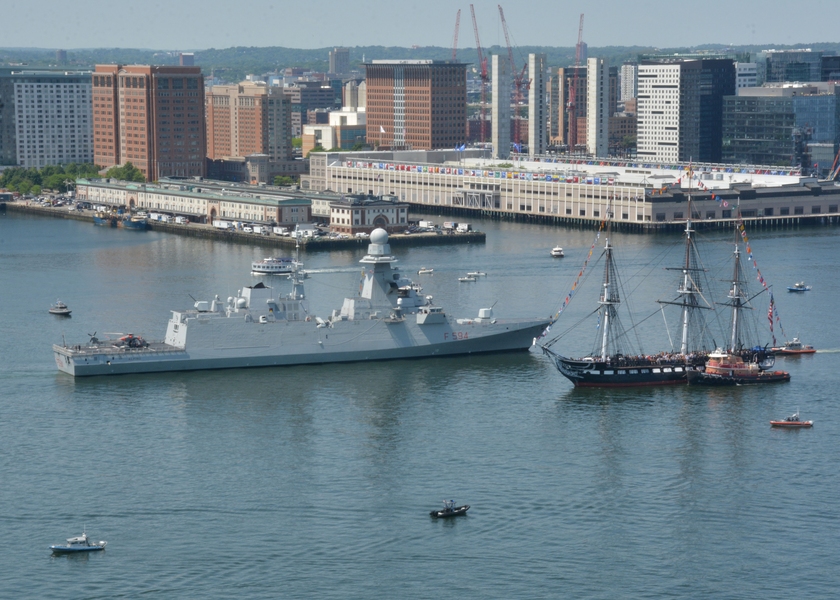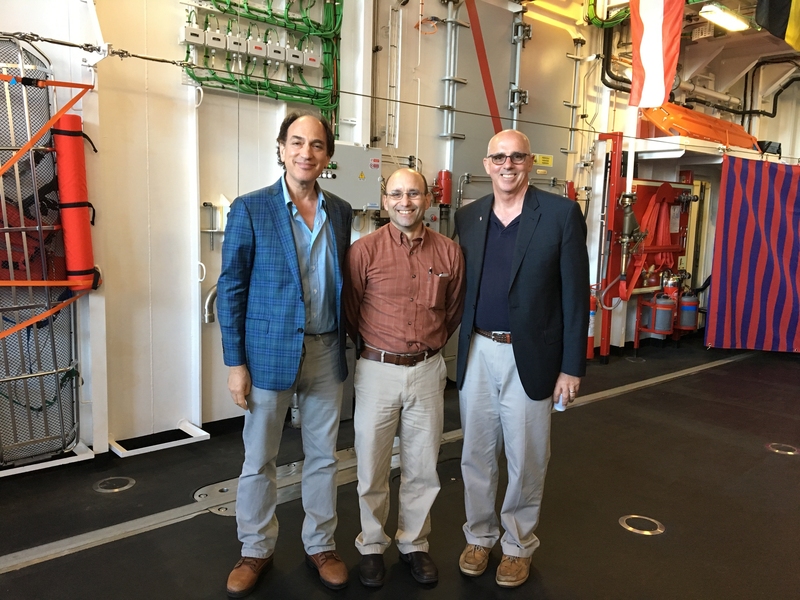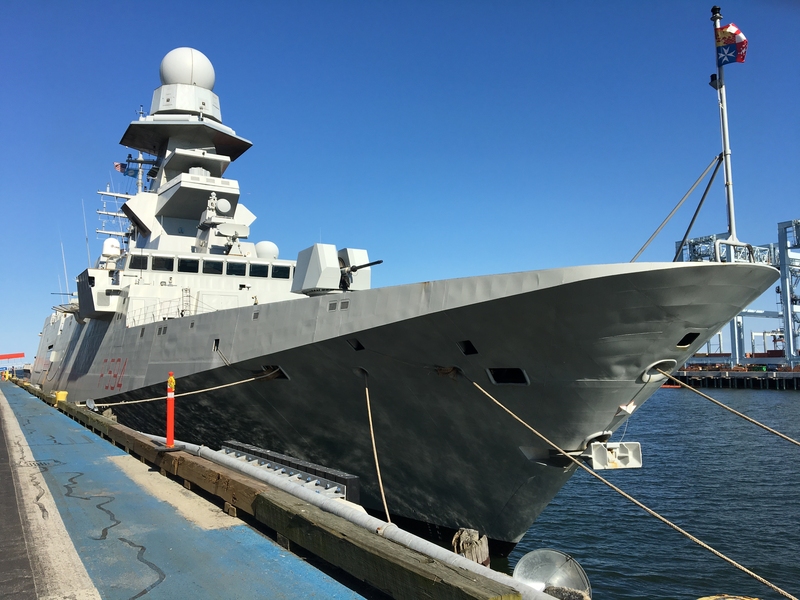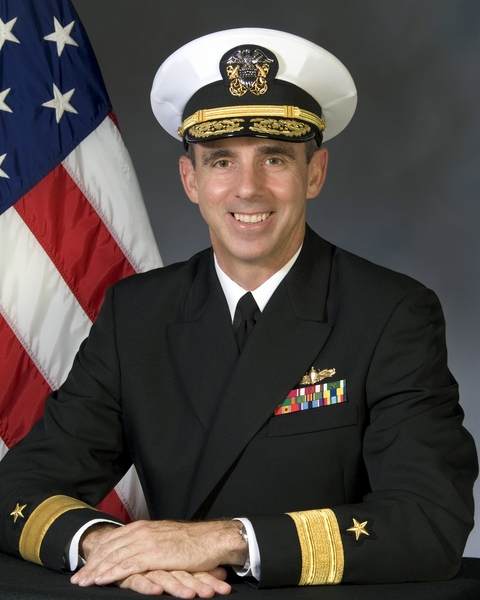Watching the USS Constitution sail around Boston Harbor is always a breathtaking sight. In June, spectators along the harbor got a particularly impressive display. The Constitution was joined on its cruise to Boston’s Fort Independence by the ITS Alpino, an Italian naval warship.
Fincantieri designed and built the ITS Alpino, and its Wisconsin company, Fincantieri Marinette Marine, has received a contract from the U.S. Navy, along with four other companies, to produce a conceptual design for the next generation of frigates — making the tour around Boston Harbor even more remarkable.
“You had the oldest frigate in the Navy sailing alongside what will hopefully be the newest frigate in the Navy,” explains Chuck Goddard OCE ’85, SM ’85, retired Navy rear admiral and senior vice president of Fincantieri Marine Group.
A graduate of MIT’s naval architecture and marine engineering program, Goddard took the Alpino’s trip to Boston as an opportunity to reconnect with the MIT community. He invited faculty members Joe Harbour, professor of the practice of naval construction, and Nicholas Makris, professor of mechanical and ocean engineering and director of the Center for Ocean Engineering, along with a number of naval construction and engineering graduate students to take a guided tour of the ship.
“It was a great opportunity to show our students the finished product of a shipbuilding project,” says Harbour.
Goddard’s involvement in Fincantieri’s bid to design the Navy’s next fleet of frigates is the culmination of four-decades of designing and building ships. His career has straddled both the public and private sector, sent him from coast-to-coast, and placed him on dry land and the open ocean.
Goddard studied naval architecture at the United States Naval Academy in the late ’70s. After graduating and a stint in Pearl Harbor, Goddard became an engineering duty officer for the Navy. It was then he was given the opportunity to enroll in MIT’s naval architecture and marine engineering program (then known as Course 13A).
“When I showed up at MIT in June of ’82, I had been out at sea for three years,” recalls Goddard. “It was fun getting back into the academic world and spending that first summer getting up-to-speed on calculus and differential equations.”
During his time at MIT, Goddard was mentored by Captain Clark “Corky” Graham ME ’67, SM ’67, PhD ’69, a professor of naval construction and engineering. They worked together on figuring out how to incorporate electric drives in naval ships. Goddard also learned about basic ship design in a civilian ship design course taught by Chryssostomos Chryssostomidis, professor of mechanical engineering ocean engineering.
After graduating from MIT, it was time to get his feet wet once more in the Navy — quite literally. Goddard was sent to Panama City, Florida, where he became a qualified Navy hard-hat diver and salvage officer. “We were the ones doing the calculations for how to raise sunken ships,” he says. “It was a very fun summer.”
Goddard was then sent to Long Beach Naval Shipyard in California where he worked on putting the USS Missouri back in commission. As luck would have it, he was soon contacted by his old mentor, Corky Graham. “I got my wish come true working with Corky at the David Taylor Model Basin in Maryland,” Goddard recalls. “We worked on electric drives again which was a real passion of mine.”
Over his 30-year career in the Navy, Goddard worked on updating their fleet with the latest cutting-edge technology. He was involved in the then top-secret project Sea Shadow, which sought to build a stealth ship, and worked as a program manager for the construction of the large destroyer DDG-1000. After his promotion to admiral, he was tasked with overseeing a dozen ship design and building programs as program executive officer for ships for the Navy. He retired from the Navy in 2008 to enter the private sector.
Goddard first joined Fincantieri in 2011, when he was asked to manage their shipyard along the Menominee River in Marinette, Wisconsin. “Actually, building ships in a shipyard was always one of my bucket list items,” he adds.
In his current role, Goddard is overseeing Fincantieri’s participation in the Next Generation Frigate FFG(X) Program. If the design of the ITS Alpino is chosen next year by the U.S. Navy, he and his team will work on incorporating U.S. radars, sonars, and combat systems within the existing design. This processing of taking an existing ship and converting it for a different role or mission is something MIT students get exposure to.
“It’s similar to a project you have to complete in MIT’s naval architecture program,” Goddard explains. “When the students were on board the Alpino, I was chatting a lot with them about their projects and what the challenges are with converting ships.”
For Goddard, FFG(X) project is a perfect bookend to his career designing and building naval ships. “I got to a design naval ships inside the Navy, and now I get to design one outside the Navy,” he adds.
While aboard the Alpino in Boston Harbor, Goddard announced that Fincantieri Marine Group has pledged $50,000 over the course of the next five years to support MIT’s Ocean Engineering Research and Development Fund.










